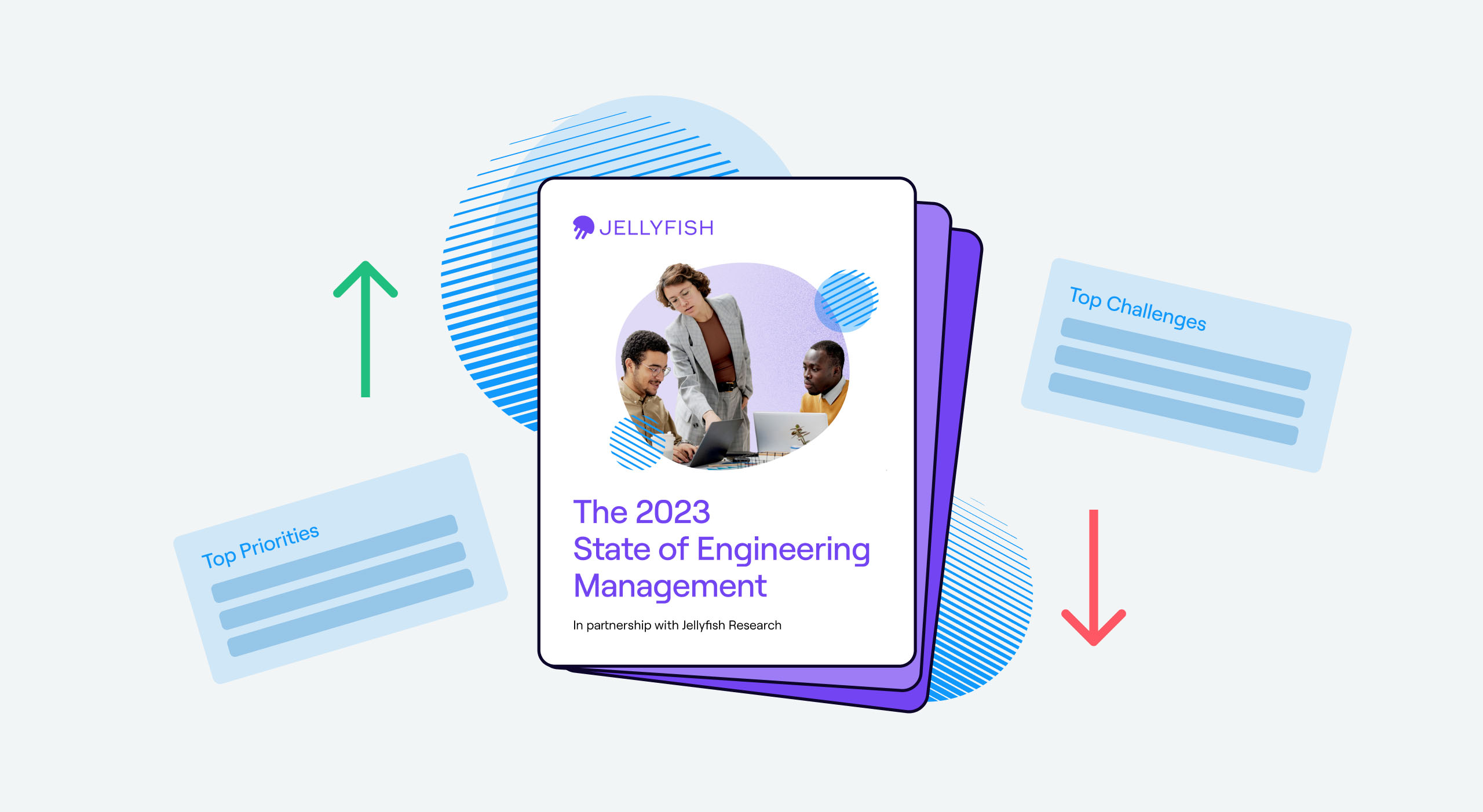This was a year unlike most as everyone sounded the alarm on a difficult economic climate. The sobering reality of this economic downturn has influenced the way that engineering leadership prepared for the coming year. And our recent research quantifies some of the impact of the hardships engineering teams faced this year.
For four years the Jellyfish team has surveyed hundreds of engineering leaders and managers across North America to better understand the holistic state of engineering leadership. We leverage our unique dataset with our Engineering Management Platform to analyze the work of thousands of engineering teams and better understand teams across three main areas:
- Where are engineering teams investing their time?
- What challenges are teams facing on an operational level?
- And are there notable differences in behavior between underperforming and overachieving teams?
This year was unlike any other, where we saw operational dropoff across several areas. But not all hope is lost as we head into 2023. In this post, we dive into the key findings from this year’s State of Engineering Management Report.
A Decline in Engineering Operational Effectiveness in 2022
For the first time in the history of the State of Engineering Management Report, software development teams trended less effective operationally across 4 key metric vectors: tempo, throughput, collaboration, and planning. This is a surprising move away from DevOps best practices.
- Teams are taking longer to complete development work, with issue cycle time and PR cycle time increasing 2.3% and 6.4% YoY.
- Teams are working on more projects at the same time, thus being pulled in many directions with less time to focus.
- Developers are working larger chunks of code at a time, with commits down 10.4% YoY and PR size on the rise.
In discussions with engineering leaders about the research results, leaders cited the drastic shift from growth to efficiency strategies as a key reason for operational whiplash. At the time of the survey (mid-Q4 of 2022) about 25% of teams faced headcount reductions and about 44% had experienced hiring freezes. The shifts in strategic priorities, coupled with reduced headcount, could be putting strain on the teams’ operations. It’s more important than ever that work is reprioritized, and that leadership and engineers alike share the new vision for their teams.
So that begs the question: what are the top priorities for engineering leaders in 2023?
2023: The Year of Engineering Operational Efficiency
If 2022 was supposed to be the year of growth for engineering teams, 2023 is turning out to be the year of efficiency. Recent survey results show that leaders are focused on efficiency and the ability to align their engineering resources to business priorities. In a word: focus.

Engineering teams are calling on leadership to provide clarity on what the priorities and focus areas are. If we see leadership’s rise to this challenge, it’s possible that the operational slowdown of last year does not become the trend in 2023. In short, not everything can be a priority in 2023, and scaling the team is not the answer to the question: “How do we achieve business objectives?”
Is Data The Answer? The Visibility and Operational Benefits Seen By Engineering Management Platform Adopters
In stark contrast to the rest of the dataset, data-driven teams leveraging Engineering Management Platforms (EMPs) saw drastically better results operationally than those that didn’t in 2022. They are moving faster, increasing throughput, increasing their team collaboration, and sticking to DevOps best practices. Here are some quick highlights from the data.
- Issue cycle times were 11% faster than non-EMP users
- PR cycle times were 8.7% faster at 2.4 days.
- PRs merged were 12% higher than other teams
- Issues resolved were up 7.8% YoY
- Commits were up nearly 7% from last year and are 20% higher than average teams.
- Data-driven teams made 21% more PR comments, and 18% more reviews than other teams.
Part of this can be explained by the compounding effect of having visibility into the impact of engineering work. For example, teams that have the access to Allocation data appear to focus more on growth and innovation work on average. They are also more mindful of taking on work that does not support current focus areas. Here are just a few findings from the data that summarize these points.
Data-Driven engineering teams leveraging Engineering Management Platforms (EMPs) are set up for success in 2023. Teams using EMPs:
- Devote 31% more of their efforts to growth and innovation work than their non-EMP using counterparts.
- Increase visibility into exactly what work is being done by 46%.
- Categorize less than 15% of their work as “Other” on average, (46% less than non-EMP users)
Closing Thoughts
Engineering leadership is already difficult enough, but it’s being made even more difficult in 2023 with an acute focus on efficiency. We now have insights that explain some of the pain points that teams have been feeling over the past year. The reasons for rising burnout among teams are related to the growing stress associated with economic pressures. Teams were measurably affected by unclear priorities, shifts in strategic direction, headcount reductions, and hiring freezes.
In the coming weeks, we’re going to be going beyond the numbers to discuss the human impact of the current climate on engineering managers, and their team members. We’ll explore what we’ve learned from the last four years of the State of Engineering Management Report and how we can apply these lessons to leading our teams through the challenging year.
This post was only a sample of the insights and takeaways from this year’s research. Download the full report today to learn more about the State of Engineering Management in 2023.







